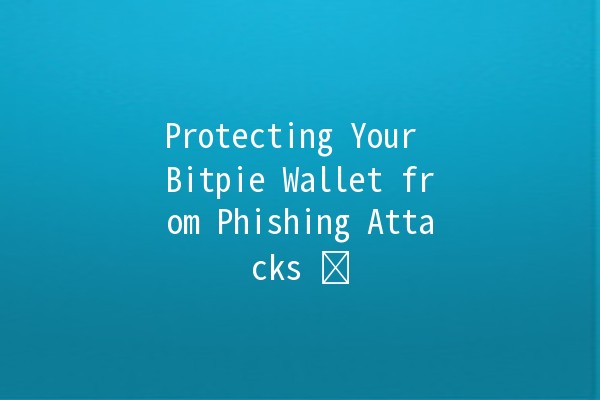
In an age where digital currencies are taking center stage, the security of cryptocurrency wallets like Bitpie becomes paramount. Phishing attacks have risen sharply in recent years, targeting users in an attempt to steal their assets. Here, we'll explore effective strategies to protect your Bitpie wallet from these malicious attacks. This article will detail practical advice and techniques, providing insights to enhance your digital asset security.
Understanding Phishing Attacks
Phishing is a technique used by cybercriminals to trick individuals into providing personal information, such as passwords, private keys, or credit card details, by masquerading as a trustworthy source. Attackers often create fake websites that resemble legitimate services, sending emails, or messages encouraging users to click on malicious links.
Common Phishing Techniques

Recognizing a Phishing Attempt
Identifying phishing attempts requires vigilance. Here are key indicators:
Suspicious URLs: Always check the URL for slight misspellings or unusual characters.
Unsolicited Communications: Be wary of unexpected emails or messages requesting personal information.
Generic Greetings: Legitimate organizations usually address users by their names, not generic terms like "Dear User."
Poor Grammar and Spelling: Many phishing emails contain grammatical errors that hint at their illegitimacy.
Effective Strategies to Protect Your Bitpie Wallet
TwoFactor Authentication adds an extra layer of security to your Bitpie wallet. By requiring a second form of verification, typically a code sent to your mobile phone, 2FA significantly reduces the chances of unauthorized access.
Implementation Example:
Go to your Bitpie wallet settings and enable the 2FA option.
Use an authentication app, such as Google Authenticator or Authy, for added security instead of relying on SMS.
Before entering your credentials, ensure you are on the official Bitpie website.
Implementation Example:
Before logging in, type the URL directly into the browser instead of clicking on links from emails or messages.
Bookmark the official Bitpie site so you can access it quickly without searching.
For users with significant cryptocurrency holdings, using a hardware wallet is a wise investment. These devices store your private keys offline, making it difficult for hackers to access them.
Implementation Example:
Purchase a reputable hardware wallet, such as Trezor or Ledger, to store your larger assets.
Regularly transfer funds from your Bitpie wallet to your hardware wallet to maintain a more secure storage solution.
Staying uptodate with the latest security patches and software is crucial. Outdated software can contain vulnerabilities that attackers exploit.
Implementation Example:
Regularly check for updates for your Bitpie wallet app and your device’s operating system.
Enable automatic updates to ensure you receive the latest security features promptly.
Using public WiFi can expose your Bitpie wallet to risks. Hackers can easily intercept data transmitted over unsecured networks.
Implementation Example:
Avoid accessing your wallet over public WiFi; if necessary, use a Virtual Private Network (VPN) to secure your connection.
Always disconnect from public WiFi after completing your transactions.
Frequently Asked Questions
What should I do if I accidentally clicked a phishing link?
If you have clicked a phishing link, it is critical to act quickly:
How can I report a phishing attempt?
Reporting phishing attempts helps protect others from similar scams. You can report phishing to:
Bitpie Support: Send an email detailing the phishing attempt.
Cybercrime Units: Conduct a search for local cybercrime reporting platforms where you can submit your report.
Email Providers: If you received a phishing email, most email providers have a reporting feature that allows you to flag spam and phishing attempts.
How do I know if my Bitpie wallet has been compromised?
Signs that your wallet may have been compromised include:
Unauthorized transactions: Check your transaction history frequently for unfamiliar transfers.
Login issues: If you are unable to access your wallet or receive alerts about multiple failed login attempts.
Unusual device activity: Check your account settings for unknown devices logged in.
What are the best practices for creating a secure password?
Creating a strong password is crucial for protecting your wallet:
Can I recover my funds if I fall victim to phishing?
If you fall victim to a phishing scheme and lose access to your wallet, recovery can be challenging. Here’s what you can do:
Immediate Action: Contact Bitpie support instantly to report the theft.
Reset Accounts: If you've used the same password elsewhere, reset those accounts immediately.
Monitor Transactions: Keep monitoring your accounts for any further suspicious activity.
Are there any specific signs that an email is a phishing attempt?
Yes, there are specific indicators to identify phishing emails:
Urgent language: Phishing emails often create a sense of urgency, prompting immediate action without careful thought.
Mismatched sender address: The sender's email address may look similar to a legitimate address but can be slightly altered.
al Thoughts
Protecting your Bitpie wallet from phishing attacks requires constant vigilance and the implementation of best practices in digital security. By enabling twofactor authentication, verifying URLs, utilizing hardware wallets, keeping your software updated, and being cautious with public networks, you can significantly reduce the risk of falling victim to these attacks. Remember, security is an ongoing effort; remain informed, and always approach your digital transactions with caution.

